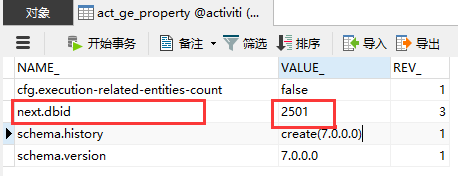创建一个简单的工作流引擎,需要准备:数据库、工作流文件(BPMN)。创建工作流的基本流程: 构建 ProcessEngineConfiguration 对象 –> 设置数据库连接 –> 设置数据库表创建属性 –> 构建一个流程引擎。其中:ProcessEngineConfiguration 对象,是构建一个简单工作流的核心 API。
为了简单的示例操作,使用 Junit 创建测试用例创建即可。
创建简单的工作流引擎
创建工作流引擎的三个方法:
- 使用 ProcessEngineConfiguration 硬编码配置数据库连接创建
- 使用 ProcessEngineConfiguration + activiti.cfg.xml 文件创建
- 使用 ProcessEngines 默认配置创建
使用 ProcessEngineConfiguration 创建
使用 ProcessEngineConfiguration 创建工作流引擎时,需要指定好数据库、库表创建策略等
1 | // 1、取得 ProcessEngineConfiguration 对象 |
使用 ProcessEngineConfiguration + activiti.cfg.xml 文件创建
此种创建方式,实际上是将数据库的链接配置,设置在了 xml 文件中。
activiti.cfg.xml 文件
1 |
|
代码示例
1 | ProcessEngineConfiguration configuration = ProcessEngineConfiguration.createProcessEngineConfigurationFromResource("activiti.cfg.xml"); |
使用 ProcessEngines 默认配置创建
使用 ProcessEngines 默认配置,实际上和 使用 xml 配置是一样的,因为使用 ProcessEngines 时会默认读取 activiti.cfg.xml 文件
1 | processEngine = ProcessEngines.getDefaultProcessEngine(); |
ProcessEngines 重点源码分析:
1 | // 默认配置 |
部署一个简单的工作流
在创建工作流成功,并且创建 BPMN 文件后,可以进行流程的部署。流程部署需要用到仓库服务,即 RepositoryService
部署操作代码示例
1 | // 获取仓库服务:管理定义流程 |
查看部署结果
- 查看 act_re_deployment 表

- 查看 act_re_prrocdef 表

bpmn 文件:
1 | <process id="levelBill" isClosed="false" isExecutable="true" name="LevelBill" processType="None"> |
其中: KEY_ 指向 BPMN 文件中 的 id, NAME_ 指向 BPMN 文件中的 name,_DEPLOYMENT_ID_ 指向 act_re_deployment 表的 id,RESOURCE_NAME_ 指向 构建 deploy 时的 classpathResource 的值
- 查看 act_ge_property 表

其中:next.dbid 的值VALUE_ 即为下一步运行部署操作时,act_re_deployment 的 id。
再次运行部署操作
再次运行部署操作,查看 act_ge_property 和 act_re_deployment 表,可以看到 act_ge_property 的 next.dbid 的值变了,且 act_re_deployment 的中 id 变为上一次运行后 act_ge_property 的 next.dbid 的值。